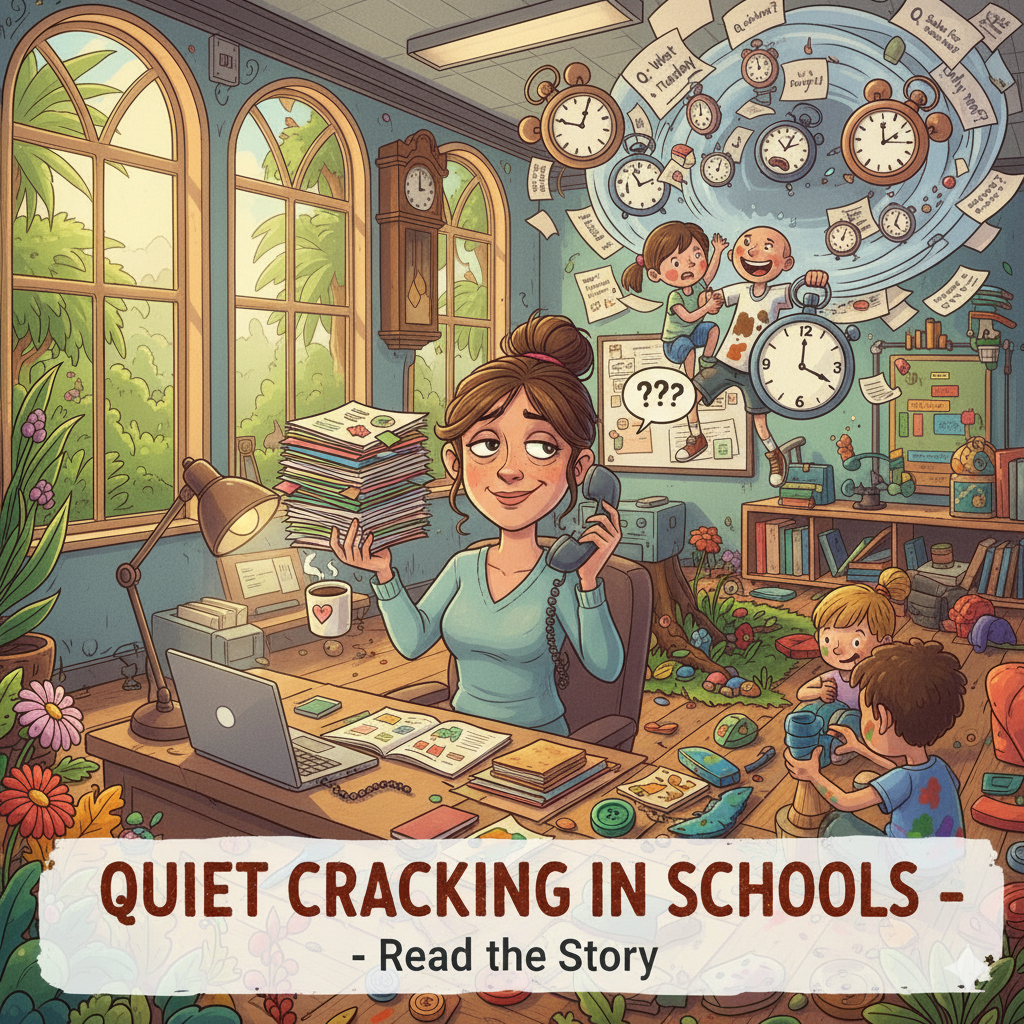
Quiet Cracking in Schools
When Teachers Perform but Slowly Break Inside
Quiet cracking in teachers is a hidden phenomenon where educators continue performing well at work, yet slowly lose engagement and motivation. In classrooms full of messy play, Reggio-inspired learning, workshops, and parent conferences, this subtle burnout quietly unfolds—impacting both teachers and learners alike.
Quiet Cracking in Teachers
Staffroom Quiz and Challenges
I still remember that staff meeting—the one that still makes me smirk. After a long day, whispers about curriculum, inspections, and policy changes swirling in the air, we were called into the room. Suspense thick. What’s this about? Another workshop? Another “reflection”?
Instead, the leader smiled and announced, “Let’s start with a fun quiz!”
The questions rolled in like a slow-motion avalanche:
“When does this child exhibit which learner profile trait in art activities? How do we align this with inquiry in maths? And which IB attribute appears when a child paints, builds with loose parts, or explores nature-inspired setups?”
After hours of teaching, stepping on Lego, wiping noses, refereeing tiny disputes over crayons, my brain looked around and saw… dust. Pure dust. I wanted to run faster than a meteor just to escape the school building. Honestly, who wants to stay longer after hours? For God’s sake!
Some colleagues nodded like perfectly trained mannequins. Others whispered about dinner plans or laundry. And the rest? Brain-brained. Literally, the only thing still working in our minds was: Let this end fast… just… let… this… end.
I, of course, couldn’t resist. I liked questioning. I always liked workshops—even the performative ones. Something to learn, maybe something to consider. But apparently, curiosity made me dangerous. Colleagues would whisper, “Aneta, please… don’t talk. No questions. Let’s just get this over with.” Hahaha. I tried, really, I tried. I whispered to myself: Just hold it together. Let it end fast. Breathe.
By the end of the session, sitting on that stage-like staffroom, I literally held bubbles inside my mouth—so I wouldn’t explode laughing, sighing, or crying. The absurdity, the dust-filled brain, the performative reflection about empathy, learner traits, and workshops—all bubbled up at once.
Quiet Cracking in Teachers
Classroom Chaos and Learning
Meanwhile, my classroom… oh, that was another universe. Painting, building with loose parts, exploring nature-inspired setups—this is what my kids lived for, and I loved being in it with them. The mess, the chaos, full-immersion play—it was magic.
Sometimes, other teachers would ask me questions—or observe me—usually the ones who had no clue, no interest in seeing teaching as something fun for adults too. “You can’t just let them play,” they’d say. “They must learn writing, counting, the standard way.” But they did learn—just differently. Writing with paintbrushes, hands, on a variety of surfaces; counting while building towers; noticing patterns while exploring loose parts. Not everyone understood this approach, but for me, it was clear: learning happens when joy and curiosity lead the way. Observing these moments reinforced why attention to the child’s experience matters—and it quietly fueled the reflections that connect to the bigger picture of quiet cracking.
My kids were dirty, busy, curious, discovering. They were experimenting with every sense, fully absorbed in their world. Blocks, paint, sand, leaves, clay, loose parts, water, sticks—you name it. That’s where learning thrived, where empathy, creativity, and inquiry came alive naturally, not on a PowerPoint slide. That’s where joy and teaching intersected perfectly.
Quiet Cracking in Teachers
Stolen Ideas and Recognition
Quiet cracking also comes from the world outside the classroom. Take ideas, for example. Once upon a time, I mentioned a simple idea to my coworkers. Ignored. Nothing. Fast forward a few days, and it appeared again… announced as “brilliant” by someone else. Me? No credit.
When I confronted them, the shrug and the classic: “You said? Hmm… I don’t know!”
I’ve heard it said that words and energy “go to the universe,” so be careful what you speak. Well, universe, thanks for recycling my words without a byline! Add the social media trend about “how you construct your sentences matters,” and suddenly I wonder: am I supposed to write a script for everything I say? Bullet points, phrasing, inflection notes? And then the kids spill paint or scatter loose parts five minutes later…
It’s exhausting. Hilarious, yes. But exhausting. And quietly, that’s another crack forming.
Performance, Observation, and the Parent-Teacher Theatre
Then there’s the SLCs and parent conferences, where the five-minute rule looms over every meeting. Sure, efficiency matters—but when a parent really wants to talk, to share concerns, to hear about their child beyond a checklist, sticking rigidly to a timetable feels… robotic. As a teacher, you sense the importance of building genuine relationships, of listening with presence, not just ticking boxes. Some parents may ask annoying questions—but those questions come from care, worry, or curiosity, and they deserve space.
I’ve watched supervisors politely guide parents out when “time’s up,” and I get it—but I can’t be that dry. I need to address their concerns fully, even if it stretches the clock. Empathetic, human-to-human connection isn’t about controlling admission numbers or compliance—it’s about trust, understanding, and respect. That’s why, often, my meetings ran last, trailing other teachers. And maybe that’s also a quiet signal of the cracks forming: balancing the pressure of schedules with the human need for connection.
Classroom observations aren’t any easier. “Just teach naturally, as if no one’s watching.” Natural? Sure. But everyone’s watching. Every block tower collapses under scrutiny, every experiment is evaluated. And instead of a learning moment, we mutter: “Can we rebuild this later?” All in the name of keeping the flow “smooth.”
Quiet cracking thrives here: in the gap between what we say matters and what we live. Performance versus reality. External expectations versus internal truth.
Reflections and Inner Wisdom
What does quiet cracking teach?
-
Boundaries: How much of yourself do you give to work that isn’t yours?
-
Awareness: Noticing when your brain turns to dust, when humor is the only survival tool.
-
Presence: Holding joy, curiosity, and love for your students, even when workshops and meetings drain you.
One kind friend took a loud, sarcastic rant of mine, polished it, dressed it up in professional-sounding language—and presented it back to me. I barely recognized it. It was my thought, but it also mirrored how easily words can be twisted when you’re not careful.
Sometimes, supervisors or colleagues eagerly weave themselves into creative work, producing brilliant, delusional, or unnecessary outcomes. It works for them—but not for me. Hahaha. And yet, we nod, smile, finish the task, survive.
Even in absurdity, in exhaustion, quiet cracking asks us to notice ourselves, to listen, and to learn before cracks become fractures. To hold what matters: authenticity, curiosity, empathy, and joy.
Quiet Cracking in Teachers
Lessons and Insights
-
Quiet cracking is subtle, often invisible, but dangerous if ignored.
-
It thrives in environments where performance outweighs presence, and words are misheard or misattributed.
-
Observe yourself: where are the cracks forming? What drains your energy versus what fuels it?
-
Protect your joy and curiosity—especially in classrooms filled with messy, magical, nature-inspired exploration.
-
Humor is your lifeline. Laugh at the absurdity before it eats you alive.


